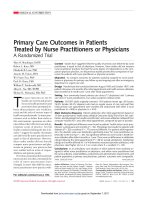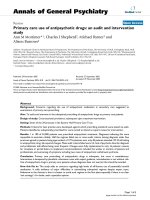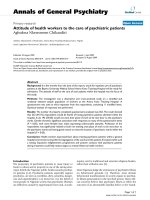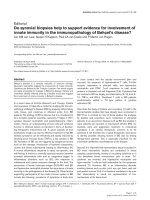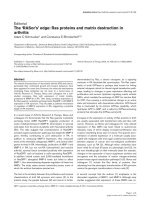Báo cáo y học: "Critical Care’s move to fund open access" pps
Bạn đang xem bản rút gọn của tài liệu. Xem và tải ngay bản đầy đủ của tài liệu tại đây (34.88 KB, 2 trang )
331
APC = article-processing charge.
Available online />Critical Care has taken the next step in its ongoing quest to
be a good scientific citizen [1]. Changing the traditional
publishing model to that already used successfully by our
publisher, BioMed Central, our open access research articles
will become financially self-sufficient through article-
processing charges (APCs). All research articles published in
Critical Care have been open access – universally and freely
available online to everyone, not only subscribers – for the
past 2 years. From August 2003, to fund this, authors of
research articles accepted for publication will be asked to
pay an APC.
Traditionally, readers pay to access research articles, either
through subscriptions or by paying a fee each time they
download an article (currently around US$20 per article [2]).
Escalating journal subscription charges have resulted in
libraries subscribing to fewer journals [3], and the range of
research available to readers is therefore increasingly limited.
Although traditional journals publish authors’ work for free
(unless there are page or colour charges), having to pay to
access research articles limits how many can read, use and
cite them.
Critical Care’s open access policy, as described in the
BioMed Central Open Access Charter [4], changes the way
in which research is published. First, all research articles
become freely and universally accessible online, and so an
author’s work can be read by anyone at no cost. Second, the
authors hold copyright for their work and may grant to anyone
the right to reproduce and disseminate the article, provided
that it is correctly cited and no errors are introduced [4].
Third, a copy of the full text of each open access article is
immediately archived in an online repository separate from
the journal; Critical Care’s research articles are archived in
PubMed Central [5] – the US National Library of Medicine’s
full-text repository of life science literature.
Open access has four broad benefits for science and the
general public. First, authors are assured that their work is
disseminated to the widest possible audience, given that
there are no barriers to access their work. This is
accentuated by the authors being free to reproduce and
distribute their work, for example by placing it on their
institution’s website. Second, the information available to
researchers will not be limited by their library’s budget, and
the widespread availability of research articles will enhance
literature searching and facilitate meta-analyses [6]. Third, the
results of publicly funded research will be accessible to all
taxpayers and not just those with access to a library with a
subscription. As such, open access could help to increase
public interest in, and support of, medical research. Note that
this public accessibility may become a legal requirement in
the USA if the proposed Public Access to Science Act is
made law [7]. Fourth, a country’s economy will not influence
its scientists’ ability to access research because resource-
poor countries (and institutions) will be able to read the same
material as wealthier ones (although creating access to the
internet is another matter [8]).
APCs will enable all of Critical Care’s research articles to be
open access. Authors are asked to pay around US$500 if
their research is accepted for publication. However, authors
from resource-poor countries [9] will have their APC waived
by the publisher, BioMed Central. Other authors can
circumvent the charge by getting their institution to become a
‘member’ of BioMed Central, whereby the annual
Editorial
Critical Care
’s move to fund open access
Elizabeth Slade
1
, Pritpal S Tamber
2
and Jean-Louis Vincent
3
1
Assistant editor, Critical Care, Editorial office, BioMed Central Ltd, London, UK
2
Managing editor, Critical Care, Editorial office, BioMed Central Ltd, London, UK
3
Editor-in-Chief, Critical Care, and Head, Department of Intensive Care, Erasme Hospital, University of Brussels, Brussels, Belgium
Correspondence: Critical Care editorial office,
Published online: 29 August 2003 Critical Care 2003, 7:331-332 (DOI 10.1186/cc2326)
This article is online at />© 2003 BioMed Central Ltd (Print ISSN 1364-8535; Online ISSN 1466-609X)
Keywords internet, open access, peer reviewed research, publishing
332
Critical Care October 2003 Vol 7 No 5 Slade et al.
membership fee covers the APCs for all authors at that
institution for that year. Current members include NHS
England, the World Health Organization, the US National
Institutes of Health, and all UK universities [10]. No charge is
made for articles that are rejected after peer review. Many
funding agencies have realized the importance of open
access publishing and have specified that their grants may
be used directly to pay APCs [11].
The APC pays for efficient and thorough peer review, for the
article to be freely and universally accessible in various
formats online, and for the processes required for inclusion in
PubMed and archiving in PubMed Central. Although some
authors may consider US$500 expensive, it must be
remembered that Critical Care does not levy additional page
or colour charges on top of this fee. These charges are
unnecessary because we include only the abstract of each
research article in print, given that readers of the print journal
tend to browse titles, abstracts and/or conclusions of
research articles, rather than read every research article
word-for-word on publication [1,12]. With the full text being
online only, any number of colour figures and photographs
can be included, at no extra cost. To provide some context,
the cost of including a colour figure in an article in Intensive
Care Medicine is US$534 [13], whereas page charges for a
typical 7 page research article in the American Journal of
Respiratory and Critical Care Medicine are US$525 [14].
Although several journals now offer free access to their
articles online, this is different from open access (as defined
by the Bethesda Statement [15]). Journals often delay free
access for 6–12 months, and even when the full text is
available readers are not allowed to reproduce and/or
disseminate the work because of restrictions imposed by the
copyright policy. That said, Critical Care is not alone in the
move to open access funded by APCs. Our publisher,
BioMed Central, currently produces nearly 100 journals
using the APC model [16]. The British Medical Journal has
recently announced that it cannot continue to provide free
access to its website [17] and is considering various sources
of revenue, including APCs [18]. Also, the Public Library of
Science is setting up two new open access journals, and
have elected to set APCs of US$1500 for each accepted
article [19]. Given that the Public Library of Science has
used television advertising to promote journals [7], the high
profile of these journals will raise awareness of open access
and encourage researchers in all disciplines to understand
and accept open access, with APCs as an acceptable
method to fund it.
Critical Care will continue to publish educational reviews,
commentaries and reports. The added editorial value of these
articles will remain funded by subscriptions, and authors will
not be required to pay APCs. By providing a forum for open
access research, in addition to this educational material,
APCs will enable Critical Care to continue its ongoing quest
to serve the worldwide intensivist community. We believe this
change will benefit clinical care and aid scientific research,
and we hope you will support this progress by submitting
your next research article to an open access journal.
Competing interests
ES and PST are employees of BioMed Central and receive a
fixed salary. As editor-in-chief, JLV receives a fixed
honorarium from Current Science Ltd, which is part BioMed
Central. ES, PST and JLV's remuneration is unaffected by the
amount of money received by BioMed Central from article-
processing charges.
References
1. Tamber PS, Slade E, Vincent JL: Critical Care: a good scientific
citizen just got better. Crit Care 2003, 7:199-200.
2. Critical Care Medicine [ />3. Mayor S: Libraries face higher costs for academic journals.
BMJ 2003, 326:840.
4. BioMed Central Open Access Charter [medcen-
tral.com/info/about/charter].
5. PubMed Central [].
6. Velterop J: Should scholarly societies embrace open access
(or is it the kiss of death)? Learned Publishing 2003, 16:167-
169.
7. Open access law introduced [ />news/20030627/04].
8. Tan-Torres Edejer T: Disseminating health information in
developing countries: the role of the internet. BMJ 2000,
321:797-800.
9. Will there be any automatic waivers? [ />faq/apcfaq.asp?txt_faq_no=12]
10. BioMed Central Institutional Members [medcen-
tral.com/inst/].
11. Which funding agencies explicitly allow direct use of their grants
to cover article processing charges? [ />faq/apcfaq.asp?txt_faq_no=8].
12. Smith R: The BMJ: moving on. BMJ 2002, 324:5-6.
13. Intensive Care Medicine Instructions to Authors [http://springer-
link.metapress.com/download/profiles/springerlink/00134-
authors.pdf].
14. American Journal of Respiratory and Critical Care Medicine
Instructions for Contributors [ />tions/ajrccm/bluecont2a.asp#ats17].
15. Bethesda Statement on Open Access Publishing [http://www.
earlham.edu/~peters/fos/bethesda.htm].
16. BioMed Central’s journals that currently have article-processing
charges [ />17. Delamothe T, Smith R: Paying for bmj.com. BMJ 2003, 327:241-
242.
18. Smith R: The BMJ will experiment with the ‘author pays’ model
(Rapid response to BMJ 2003;327:241-2). [ />eletters/327/7409/241#35308].
19. Public Library of Science to launch new free-access biomedical
journals with $9 million grant from the Gordon and Betty Moore
Foundation [ />

